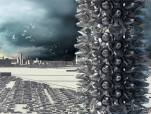Megacity as a Settlement Unit

The kinetic skyscraper by Ukrainian architects Victor Kopeikin and Pavel Zabotin was one of 32 honorable mentions of eVolo Skyscraper 2011. Today we represent the views of the authors on modern urban agglomerations and relevant challenges to be solved.
Further urbanization is a one-way process, and since the edge of 19-20th Centuries the urban population is growing exponentially. In the middle of 20th Century the concept superagglomeration, which is the largest urban form constituted by merging of neighboring cities, was invented. For the first time the term «Megalopolis» was used to denote a continuous urban extension along the Atlantic coast of the USA (over 1000 km and up to 200 km wide) consisting of interconnected agglomerations of Boston, New York, Philadelphia, Baltimore, Washington (40 million of residents).
As a rule, a megalopolis is spontaneously generated highly urbanized territory. Its main features are: linear development mainly along highways and railroads; generally polycentric structure due to interaction of densely situated agglomerations. The number of megacities keeps on growing. The fused relatively small agglomerations transform into coherent whole of million and even more inhabitants. We can give such clear examples of mega-cities like Shanghai - 24 million people. Tokyo - 13 million people., New Delhi - 11.9 million people., Moscow, Russia – 11.5 million people., Mexico City - 8.7 million people.
One of the most rapidly developing megacities is Mexico City. It was chosen for the analysis of urban life support challenges. The area of the Mexico City as of 2000 is 1,485 km2, population - 8720 thousand people, population density - 5875 residents per km2, agglomeration - 24 million people. What would be its future in terms of ecology, agglomeration issues and demographic situation by 2050? The predicted noise pollution is 100-110 dB, at an acceptable pain threshold of 120 dB.
The forecast is based on aver age increase in noise level at 0.8 dB per year, considering the allowed rate of 60-70 dB. The natural internal and external background radiation, which is now app. 200 Mrem a year, grows up to 420 Mrem a year. Electromagnetic pollution will also rise: interior wave radiation up to 90-95 Hz, urban background radiation up to 100 - 110 Hz (normal index - 60 Hz). The average temperature also changes. Today it grows by 0.5 degrees over 5 years on average resulting 6 degrees by 2050.
The predicted urban population of the Mexico City will reach 29.8 million by 2050, i. e, it will grow more than 3.3- fold compared with 2000. We’ll face the changes of other vital parameters, such as resource consumption and domestic and industrial waste pollution.
Full version you can download here
 Text and illustrations by Victor Kopeikin and Pavel Zabotin
Text and illustrations by Victor Kopeikin and Pavel Zabotin


